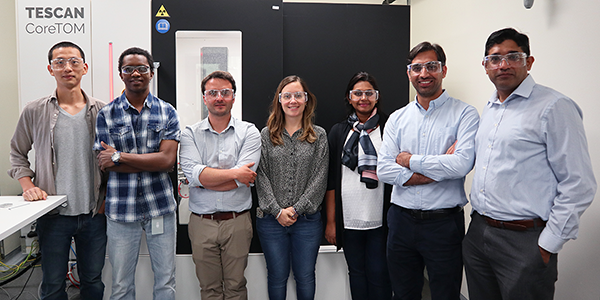.jpg?sfvrsn=39330263_0)
.jpg?sfvrsn=39330263_0)

28 August, 2019
The CoreTOM CT scanner currently residing in the ANPERC laboratory is the product of two years of careful research and design, chosen to expand the scope of the center's research capability. The machine can image samples on the scale of a few microns to tens of centimeters, enabling ANPERC researchers to study geological samples and fluid flow through heterogeneous porous media.
"I identified XRE at a conference two years ago," says Center Director Dr. Tadeusz Patzek. "What caught my attention was their elegant design and flexibility." The long process of stocking the center's laboratory with the tools scientists and students need has taken patience and perseverance. "We used some of our start-up capital for this."

Much of the work of ensuring a scanner that met the center's needs fell to ANPERC research scientist Dr. Viswasanthi  Chandra. "When I first arrived about two and a half years ago, I realized the center and the scope of our research was growing. We saw a need for a scanner that was efficient but still flexible, with wider applications that were still unknown. Often there is not one scanner that is fit for everyone; some are low resolution using large samples, some are high resolution but require extremely samples. We needed a machine that does both." In the summer of 2017 Dr. Chandra travelled to Ghent to meet the XRE team.
Chandra. "When I first arrived about two and a half years ago, I realized the center and the scope of our research was growing. We saw a need for a scanner that was efficient but still flexible, with wider applications that were still unknown. Often there is not one scanner that is fit for everyone; some are low resolution using large samples, some are high resolution but require extremely samples. We needed a machine that does both." In the summer of 2017 Dr. Chandra travelled to Ghent to meet the XRE team.
"I had to make sure that a spinoff company from the University of Ghent could handle a large order from Saudi Arabia, and are able to provide long term maintenance and technical support. They advised modifications for a whole range of projects, with room for future improvement. The ability of the system to image at both large and small scales was very unique. The machine is capable of quick and long exposure scanning, as well as fast "4D" scanning to image dynamic flow."


Transporting the CT scan safely from Europe to Saudi Arabia was a logistical challenge.
Besides applications in the study of enhanced oil recovery, the CoreTOM scanner is useful for geology and geoscience research, and numerous additional research applications relating to thermo-hydro- mechanical- chemical (THMC) processes in porous media. Comparing the capabilities of existing scanners to the new research opportunities opened up by this machine, says Dr. Chandra, is like comparing "a scooter to a Bentley."
ANPERC students have already begun using the CT scanner for a variety of research projects, including members of Dr. Carlos Santamarina's EGEL research group. The next installment will demonstrate how students and researchers are putting this powerful new machine to use.

